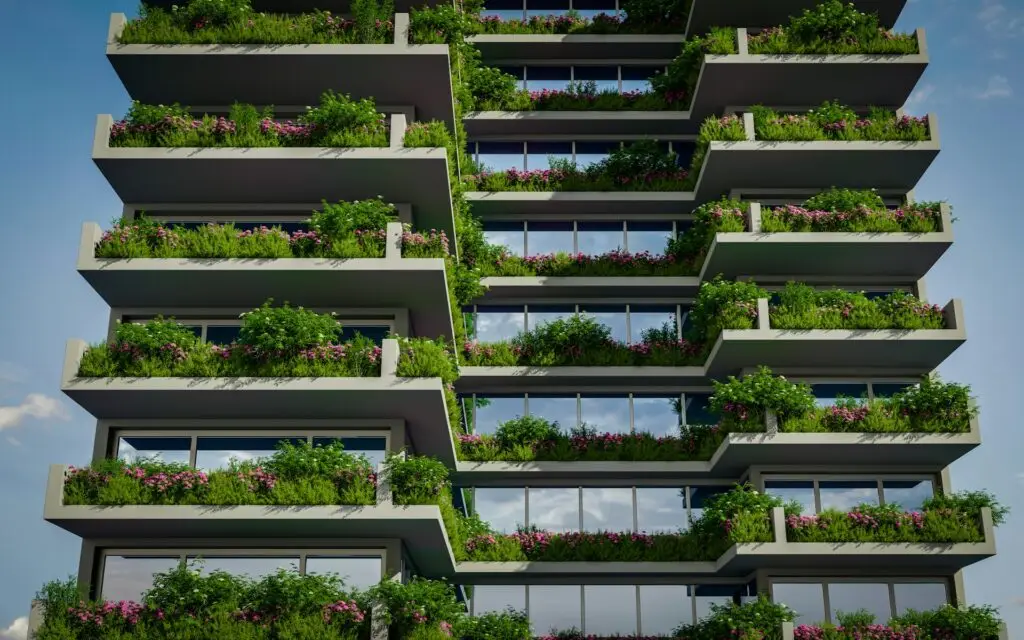Biophilic Principles
Positive Environmental Impacts of Biophilic Principles
Biophilic design integrates natural elements into built environments, fostering a harmonious connection between humans and nature. This approach has profound positive impacts on the environment, influencing carbon footprints, energy efficiency, biodiversity, innovation, and aesthetic appeal. Here’s how embracing biophilic principles can contribute to a sustainable and thriving future.

Reducing Carbon Footprints
Biophilic principles encourage the integration of natural systems that actively reduce carbon emissions:
• Carbon Sequestration: Incorporating living plants in architecture captures and stores carbon dioxide, mitigating climate change.
• Urban Cooling: Natural elements like green roofs and walls reduce heat absorption, minimizing the energy needed for cooling.
• Sustainable Materials: Biophilic designs often use eco-friendly materials with lower embodied carbon, reducing overall emissions.

Energy Savings and Efficiency
Biophilic environments optimize energy use, making buildings more sustainable and cost-effective:
• Natural Lighting: Maximizing daylight reduces reliance on artificial lighting, lowering energy consumption.
• Thermal Regulation: Green walls and roofs provide insulation, stabilizing indoor temperatures and decreasing heating and cooling needs.
• Ventilation: Incorporating natural airflow designs reduces dependence on mechanical ventilation systems, further cutting energy use.

Enhancing Biodiversity
Biophilic designs create habitats that promote diverse ecosystems, even in urban areas:
• Green Spaces: Parks, gardens, and living walls support native flora and fauna, improving urban biodiversity.
• Pollinator Pathways: Strategic planting of pollinator-friendly plants fosters the survival of bees, butterflies, and birds.
• Microhabitats: Biophilic features like water elements and vertical gardens provide refuge for small species, enhancing ecological resilience.

Driving Innovation
Biophilic principles inspire advancements in architecture, design, and technology:
• Smart Green Systems: Innovations like automated irrigation and IoT-driven plant monitoring optimize biophilic designs.
• Eco-Conscious Materials: New materials that mimic nature’s efficiency—such as self-cleaning surfaces inspired by lotus leaves—are gaining popularity.
• Sustainable Urban Planning: Biophilic cities integrate green corridors and community-focused natural spaces, setting new benchmarks in urban design.

Aesthetic Advantages
Biophilic designs combine functionality with visual appeal, creating spaces that inspire and rejuvenate:
• Natural Beauty: Integrating plants, water features, and organic textures enhances the sensory experience.
• Stress Reduction: Studies show that natural elements reduce stress, promoting mental well-being and productivity.
• Versatile Designs: Biophilic principles offer flexibility in creating unique, visually engaging environments that suit diverse needs.

Potential Benefits of Biophilic Principles
• Health and Well-being: Enhanced air quality, reduced stress levels, and increased productivity in biophilic environments.
• Economic Savings: Reduced energy costs and increased property value through sustainable and appealing designs.
• Community Engagement: Green spaces foster stronger social connections and a sense of community.
• Environmental Stewardship: Adoption of biophilic principles reflects a commitment to preserving the planet for future generations.
Conclusion
Biophilic principles bridge the gap between the natural and built worlds, offering transformative benefits for the environment and humanity. By reducing carbon footprints, boosting energy efficiency, enhancing biodiversity, driving innovation, and creating aesthetically pleasing spaces, biophilic design sets a precedent for sustainable development. Embracing these principles is not just a design choice—it’s a commitment to a better, greener future.
Ready to embrace biophilic design? Let’s build spaces that inspire, sustain, and thrive together.